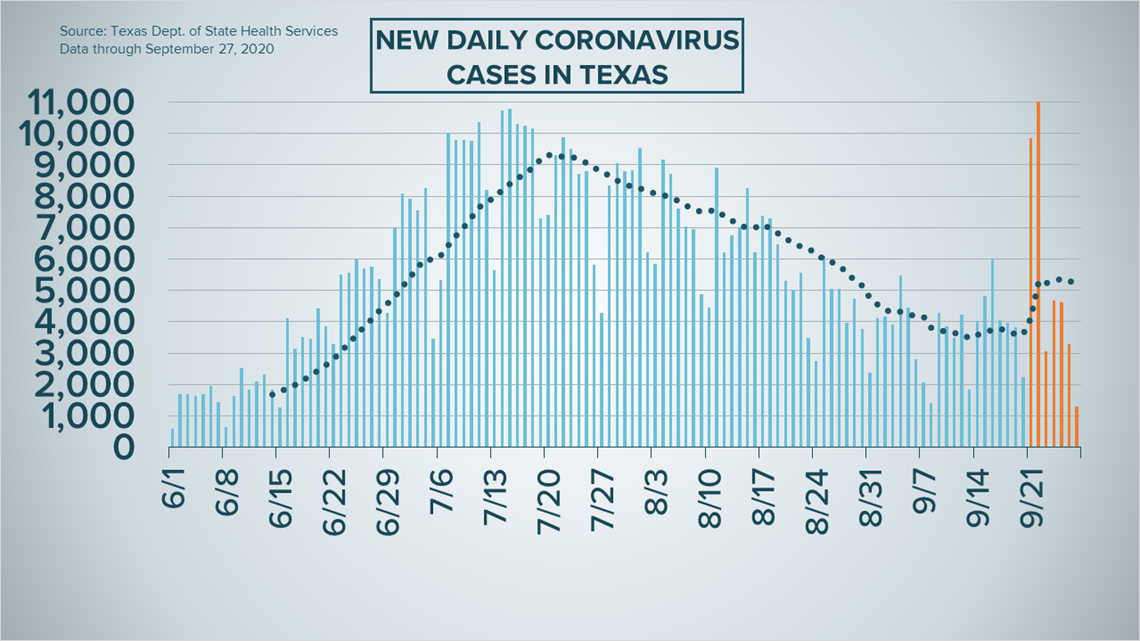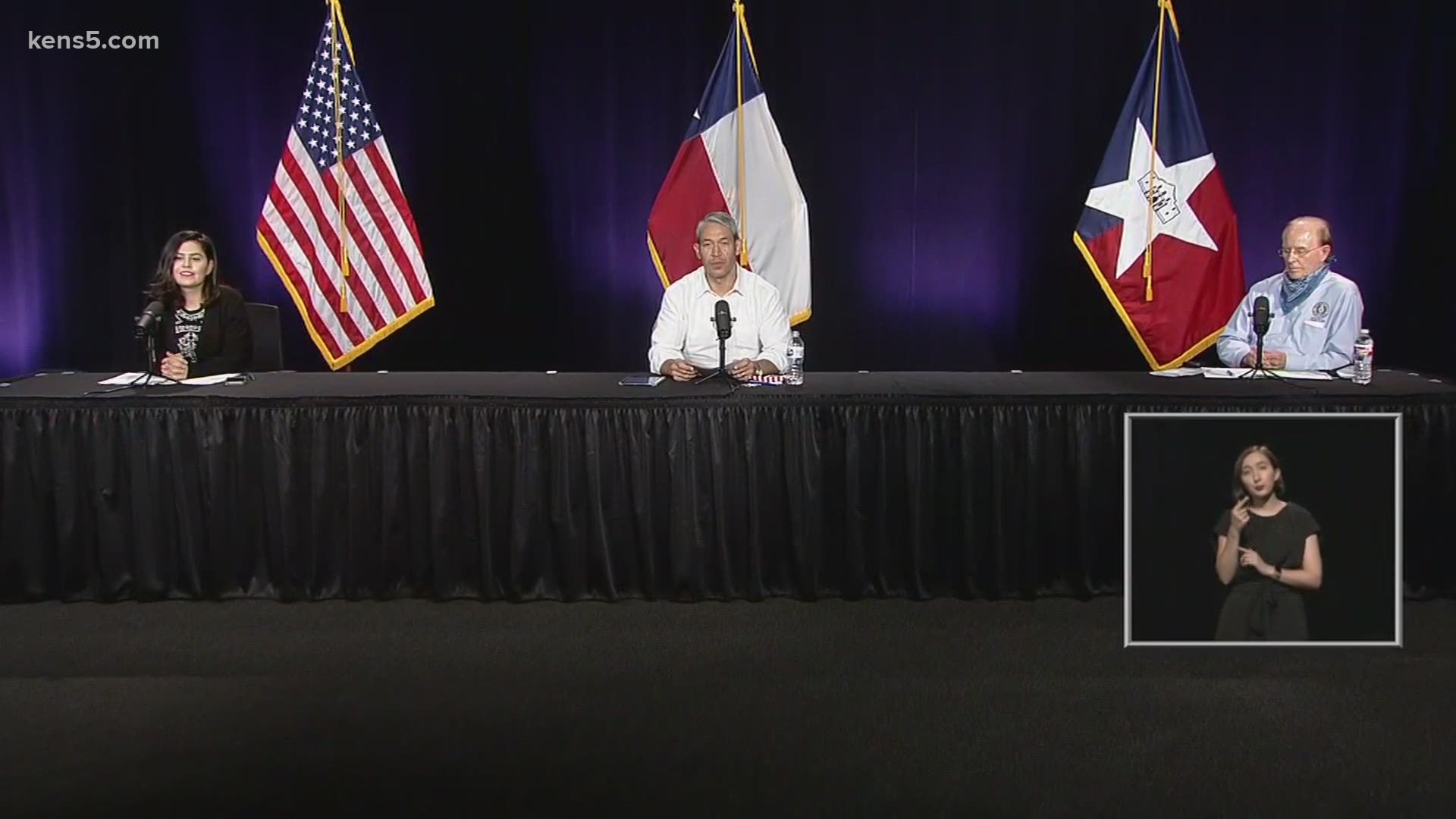SAN ANTONIO — We're tracking the latest numbers from the coronavirus pandemic in San Antonio and across Texas. Here are the latest numbers reported by Bexar and surrounding counties:
- Bexar County: 63 new cases were reported Monday, bringing the total number for the county to 57,208. The county death toll remained at 1,130 as no new fatalities were reported.
- Comal County: The county reported 21 additional cases on Monday, seven of which were attributed to a backlog. No additional deaths were reported. There have been a total of 3,431 cases of COVID-19 in the county – including 2,714 confirmed cases – while 116 county residents have died. County officials say there are 200 active coronavirus cases, and 3,115 residents are considered recovered.
- Hays County: Officials in Hays County on Monday reported 45 new cases in the county and no additional virus-related deaths. As of Monday, there are a total of 5,871 lab-confirmed cases in the county (1,529 of which are active) while the death toll remains at 54. 4,333 residents have recovered from the virus.
How Bexar County is trending
We've tracked how many coronavirus cases have been confirmed in Bexar County from the time officials began reporting cases in March 2020. The graphic below shows the number of cases since June and charts those daily case numbers along a 7-day moving average to provide a more accurate picture of the overall coronavirus case curve in our area and the direction we're trending amid the pandemic.
On Monday, San Antonio Mayor Ron Nirenberg reported 63 new coronavirus cases in Bexar County. That brings the number of residents who have been diagnosed with the virus to at least 57,208 since the pandemic started.
Nirenberg reported no new coronavirus-related fatalities. In all, 1,130 local residents have died from COVID-19 complications.
Hospitalization numbers in the county remained fairly steady on Monday. A total of 220 Bexar County residents were receiving treatment for COVID-19 symptoms, which is one less than Sunday. The number of patients on ventilators (34), and the number of those in intensive care (86) both remained steady.
The positivity rate is now at 5.9%, which officials say is a step in the right direction, but not yet under the goal of 5%.
The risk assessment is still as low as possible, but the classification has changed from "safe" to "low", and Nirenberg emphasized that your safety still depends on the decisions you make and the risks you take.
Coronavirus in Texas
The number of Texans who have tested positive for the coronavirus since the pandemic began grew by 4,504 on Monday, according to the Texas Department of State Health Services. Of that increase, 1,397 are attributed to newly-reported coronavirus cases. Another 3,107 cases in the total stem from a number of backlogs throughout several counties:
- 313 older cases reported in Harris County.
- 2,794 older cases reported in Bexar County


State officials also reported 11 new fatalities Monday, bringing the total number of Texans who have died due to coronavirus to 15,533. In total, 739,743 Texans have tested positive for COVID-19. An estimated 657,407 have recovered.
The number of hospitalizations on Monday dropped slightly to 3,201, which amounts to 16 less Texans receiving treatment for COVID-19 symptoms in the last 24 hours.
The state's public school COVID-19 data dashboard had reported 1,212 new student cases for the week last week, bringing the total to 3,445 positive cases out of an estimated 1.1 million students learning in-person. The total count of on-campus staff cases rose to 2,850 after 660 new cases were reported. The data on the DSHS' website will be updated weekly on Wednesdays.
Meanwhile, the state on Thursday reported that, as of this week, there have been 86 cumulative COVID-19 cases between on-campus staff and students between San Antonio's three biggest districts. More on that can be found here.
The number does vary from figures reported by Nirenberg at Thursday evening's COVID-19 presser, where he said that a total of just 52 students and staff "across our area" have tested positive. It's unclear what accounts for the discrepancy.
Latest Coronavirus Headlines
- Have a cough? How to tell if it is fall allergies or the coronavirus
- US to ship millions of tests in push to reopen K-12 schools
- Halloween masks & COVID-19: The CDC warning every parent should know
- UN failures on coronavirus underscore the need for reforms
- Black Friday sales may start earlier as retailers try new tactics to attract weary shoppers
Coronavirus symptoms
The symptoms of coronavirus can be similar to the flu or a bad cold. Symptoms include fever or chills, cough, shortness of breath or difficulty breathing, fatigue, muscle or body aches, headache, new loss of taste or smell sore throat, congestion or runny nose, nausea or vomiting and diarrhea, according to the Centers for Disease Control.
Most healthy people will have mild symptoms. A study of more than 72,000 patients by the Centers for Disease Control in China showed 80 percent of the cases there were mild.
But infections can cause pneumonia, severe acute respiratory syndrome, kidney failure, and even death, according to the World Health Organization. Older people with underlying health conditions are most at risk.
But infections can cause pneumonia, severe acute respiratory syndrome, kidney failure, and even death, according to the World Health Organization. Older people with underlying health conditions are most at risk.
Experts determined there was consistent evidence these conditions increase a person's risk, regardless of age:
- Chronic kidney disease
- COPD (chronic obstructive pulmonary disease)
- Obesity (BMI of 30 or higher)
- Immunocompromised state (weakened immune system) from solid organ transplant
- Serious heart conditions, such as heart failure, coronary artery disease, or cardiomyopathies
- Sickle cell disease
- Type 2 diabetes
The CDC believes symptoms may appear anywhere from two to 14 days after being exposed.
Human coronaviruses are usually spread...
- Between people who are in close contact with one another (within about 6 feet).
- Through respiratory droplets produced when an infected person coughs, sneezes or talks. These droplets can land in the mouths or noses of people who are nearby or possibly be inhaled into the lungs.
- Some recent studies have suggested that COVID-19 may be spread by people who are not showing symptoms.
Help stop the spread of coronavirus
- Stay home when you are sick.
- Eat and sleep separately from your family members
- Use different utensils and dishes
- Cover your cough or sneeze with your arm, not your hand.
- If you use a tissue, throw it in the trash.

